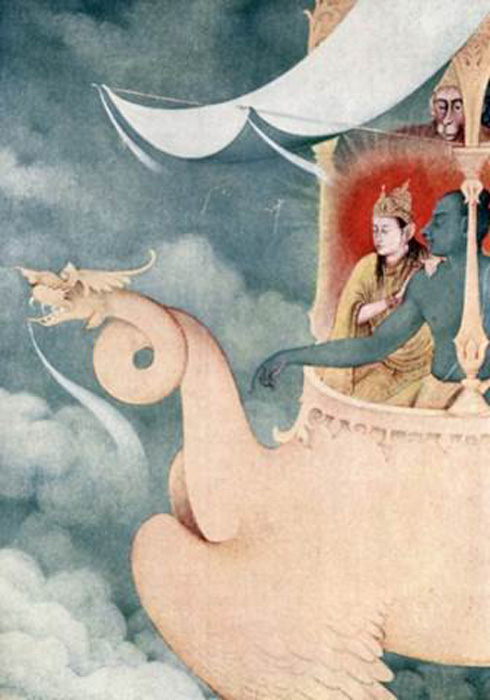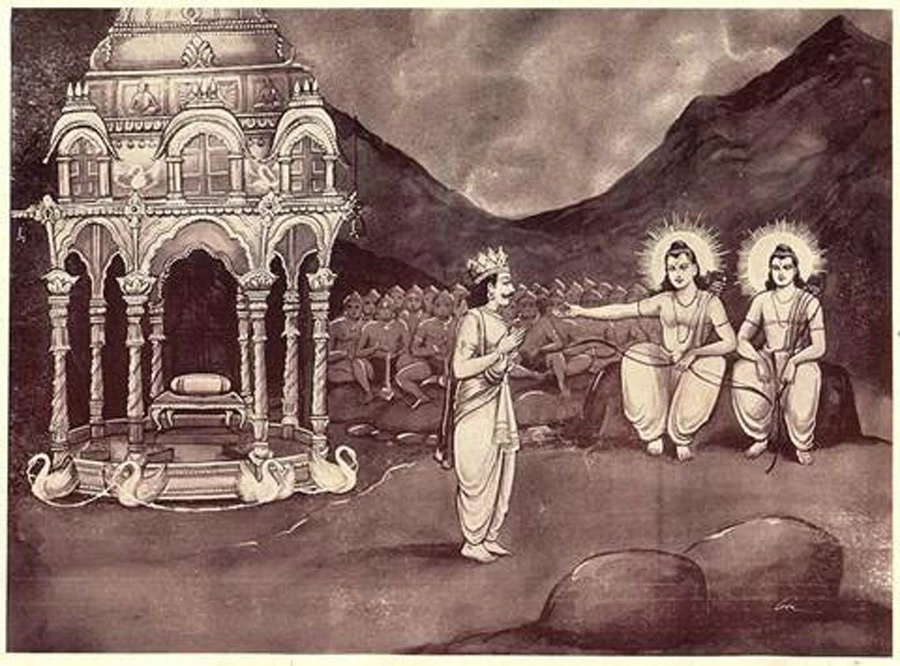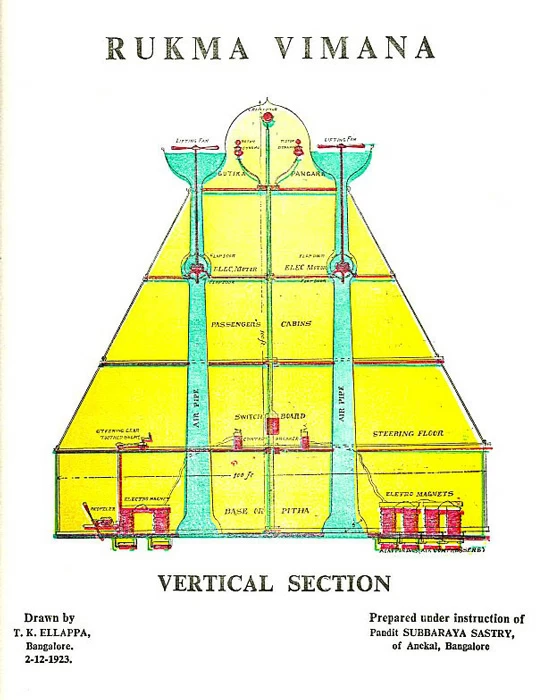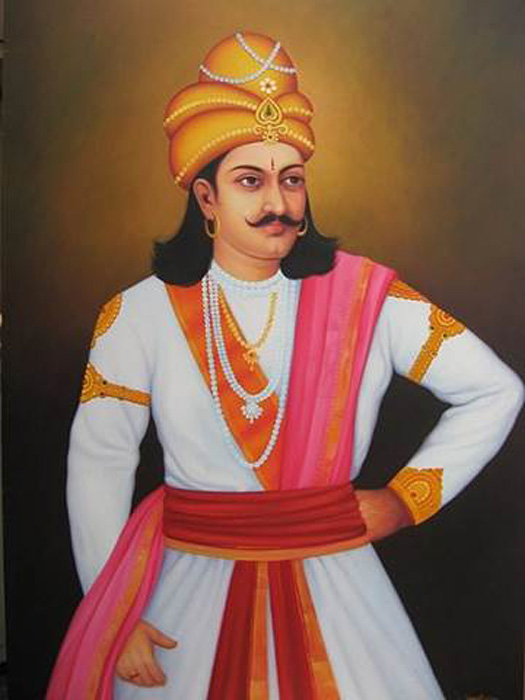The Hindu ancient texts and Vedas (religious teachings) are full of amazing stories about different gods, their extraordinary powers, and battles that took place many centuries ago. Their sagas are perceived as mythological stories that create useful lessons for application in real life.
These myths describe gods who fight with against evil forces on flying crafts. These were originally known as “Ratha” before being more commonly referred to as “Vimana” meaning traversing or measured out. Vimanas are flying chariots, or even flying palaces, mentioned in Sanskrit epics and Hindu texts.
The Pushpaka Vimana of Ravana, the central antagonist in the Hindu epic of Ramayana, is a great example. These flying chariots are also mentioned in the Edicts of Ashoka in the 3rd century BC, as well as Jainist texts.
Similar to the chariots of ancient biblical texts, these aircraft came in different sizes and various shapes that could travel at several speeds to different distances. Some of them were seafaring and land vehicles, while others even flew to the Moon or even further.
Most flying saucers come from authentic ancient Indian texts, of which many are ancient epics themselves. Most of these texts have not been translated into the English language.
So, we are faced with consistent textual evidence of flying machines used in ancient battles, described with details which seem to suggest extremely advanced technology. We even have ancient manuals on how to pilot these craft. What exactly are we looking at here?
Vimanas In The Vedas
The Vedas are some of the oldest Indian texts to describe Vimanas, and they come in various shapes and sizes. There is the elephant-vimana with numerous engines, the agnihotra-vimana with two engines, and many other types named after animals or birds.

Rig Veda, which is a part of the Vedic texts, refers to the flying machines known as Ratha. The Yajurveda, another part of Vedic texts, also contains the name Vimana.
These Vimanas are consistently described as weapons of war. The Asvins, the Atlanteans in the Indian texts, show that they were more technologically advanced than the Indian people. The Atlantean “Vailixi” are described as flying machines having a cigar-like shape and had the ability to maneuver both underwater and in outer space.
In the text of Yantra Sarvasva, an ancient guide to these machines, sage Maharshi Bharadwaj tells about three classes of Vimana, based on their range. Some Vimanas were made to travel locally from one place to other. In the second class, the Vimanas were used to travel to different countries, and in the third class, these flying machines were used to travel to various planets.
These Vimanas were non-combustible, unbreakable, and were also invisible to the enemies. They were just as effective on the offensive, able to render enemies into a suspended animation state and cause widespread destruction.
Vimanas In The Hindu Epic Texts
In the ancient Hindu texts, the empire of Rama (in the north of modern-day India, including some parts of Pakistan) existed nearly fifteen thousand years ago. It existed during the time of Atlantean civilization, which was ruled by Priest-Kings.
The greatest seven cities of the empire were called the Seven Rishi cities, and these people had flying machines named Vimanas. There are four Vimana types described in the text. Some were saucer-shaped, whereas others were cylinder-shaped.
These flying machines are described in detail, as circular aircraft with portholes over two decks, and a dome. A Vimana is described as flying with the wind’s speed and producing a melodious sound.
The ancient Indians who created those ships also wrote flying manuals about the controls of several Vimana types. Many of these manuals are still in existence and offer an unexpectedly detailed guide for piloting these craft.
Famous Vimanas
The Pushpaka Vimana, brought by Ravana, the demon king in the Hindu epic Ramayana, is the first Vimana in the Hindu texts. It is described as resembling the Sun. The Vimana moved at the will of the pilot, and when Rama, the protagonist of the text, got in, the chariot followed the king’s command and flew to a higher altitude.

This Vimana was made by Lord Vishwakarma for the Hindu creation god Brahma. Later on, Brahma presented it to Kubera or the wealth God, before it was stolen by his half-brother, the Lanka demon king Ravana.
The Mahabharata, another Hindu epic, provides even more detail on a Vimana. The ancient Indian king Salva acquired the flying machine from Maya Danava, who was a resident of a planetary system named Taltala. The Vimana flew in the sky, rested on the hill, and floated on the water.
The craft was called Saubha, and could go anywhere, and Salva used it to kill several valiant Vrishni (ancient Yadu dynasty heroes). The aircraft of Salva is described as being able to become invisible, which wrong-footed the Yadu dynasty warriors.
Another Vimana is described in the Dronoparva, which is a part of the Mahabharata. Here it has a sphere-like shape and was created on the winds produced by the planet Mercury.
The epic describes that Bhima, who flew in this Vimana, generated an enormous ray like the Sun and created noise like the storm’s thunder. This is mentioned in Vaimanika-Shastra, a text on the science of aeronautics relating to these Vimanas.
How Did They Work?
There are a total of 32 secrets that describe Vimana’s work. The pilot must know the airplane’s structure, and have the knowledge of how to drive the craft.
The pilot should also know the means of taking off to the sky, and know how to maneuver without crashing. These secrets were expected to be known by the pilot as given in Rahasya Lahari, a guide to Vimana operation.

The pilot should also have the training in “taantrica” and “maantrica” (related to tantras and mantras), “kritaka,” “antaraakalaka,” “adrishya” and “drishya” (how to be seen and unseen), “goodha” (how to be hidden), “paroksha” and “aparoksha” (how to manage contraction and expansion), “chaapala” (how to be quick), “stabdhaka” (how to paralyze), and so on.
These are no vague references to unexplained phenomena, these are detailed instructions written by a seeming expert. They even seem to address modern aeronautical issues which would likely impact such a craft in real-world situations.
Take the instructions relating to goodha for example. To hide the flying machine from enemies, the pilot is instructed to harness the power in the 8th-atmosphere layer above the earth, and to attract dark solar rays.
Drishya tells the secret of collisions between wind and electricity in the atmosphere with the resultant glow mirrored in front of the Vimana. This creates a “Maaya Vimana” or a camouflaged Vimana.
The texts go into considerable detail as to the metal construction of Vimanas, their use of mirrors, and lenses, and the defenses offered by several Vimana types.
Ancient Weaponry
There are even instructions on the control panel operation within Vimanas. Roopakarshana describes a television which allows the pilot to see inside enemy Vimana.
Chaapala, known for its higher speed, is accelerated by pressing a centrally mounted switch in the Vimana’s middle section. Activated when an enemy’s machine is spotted, the Vimana travels at “4,087 revolutions wave speed.”
Stabdhak launches a poisonous attack, projected through the Vimana’s north side, which renders the crew of the enemy’s craft unconscious. In the Sowdaaminee Kalaa (the science of electronics), Parashabda Graahaka is described as a sound capturing device, enabling the pilot to eavesdrop inside the enemy plane.

As per Shaunaka, the sky is divided into different regions. These are Mandala, Rekhaapathaha, Shakti, Kakshaya, and Kendra. Within these atmospheric regions, there are seven Lokas or worlds where Vimanas traveled.
Dhundinaatha and Valalmeeki Ganita, ancient intellectuals, state that there are 70,300,800 air routes in Rekha. In Mandala, there are 200,800,200 air routes. Shakti has around 1,001,300 air routes, Kakshaya has nearly 30,900,300 air routes, and Kendra has a total of 3,008,200 air routes.
Vimanas and Jainism
Vimana-Vasin, or “the dweller in Vimana,” is the order of deities who served Mahavira, the Jain Tirthankara (religious teacher). These Vaimanika deities reside in the heavens, known as the Urdhva Loka.
As per the Kalpa Sutra, Bhadra-bahu’s famous text, the 22nd and 24th Tirthankaras arrived on Vimanas, called Puspa-Uttara Aparijita. The Abhinandana or 4th Tirthankara as well as Sumati-Natha or 5th Tirthankara traveled through the sky in a Vimana, named Jayanta after the Sava-artha-siddhi Vimana owned by the Jayanta deity. The 15th Tirthankara Dharma-natha traveled in the sky using a Vimana named Vijaya.
Jainist texts even mention Vimanas that can be seen in dreams, known as the Nalini-gulma Vimanas.
Vimanas In The Ashoka Edicts
With Atlantis’s cataclysmic sinking and ending of the rule of Rama, the world entered into a Dark Age. Many of the Vailixi and Vimanas of Rama were destroyed, but some were said to have survived.
- Madonna with Saint Giovannino: Painting with a UFO?
- Starlite: The Mysterious Material that Could Not Burn
Some 1,000 years after the Vedas, Ashoka, an Indian emperor of the Maurya Dynasty, describes an aerial chariot or “Viman” as featuring in a procession for festivities which were organized in his reign. This was not unique.
Ritual drums were sounded during the period of King Devanampriya Priyadarsin, to represent moral behaviors and discourage killing. These represented elephants, aerial chariots, and other divine figures, as mentioned in the Ashoka Edicts.
Ashoka created a secret society comprising the Nine Unknown Men, great scientists who cataloged many sciences. The King kept all their work secret as he feared that the advanced science of these men could be used for some evil purposes during the war.

The Unknown Men each wrote a book. One such book tells about the secrets of gravity and how to master it. This text is believed to still exist, but its location has been lost. It is kept somewhere in an Indian library, or possibly North America or Tibet.
The Vaimanika Shastra
Texts on the Vimanas have continued to be written up to the present day. The Vaimanika Shastra is a Sanskrit text on the subject of aeronautics, written in the early 20th century following deep mental channelling and meditative inspiration.
It tells of the creation of the Vimanas, referred to as the construction of God’s chariot. The existence of this text was revealed by G.R. Josyer in 1952, who said Pandit Subbaraya Shastry had dictated it to him from 1918 to 1923.
The text consists of eight chapters divided into 3,000 shlokas. Pandit Shastry allegedly stated the content was divinely given to him by Maharishi Bharadvaja.
The Amarangasutradhara, a key text on Vimanas explains that five craft were initially created for the gods Brahma, Yama, Vishnu, Indra, and Kuvera. Later there were many additions. Four important flying Vimana types are Sundara, Rukma, Sakuna, and Tripura.
The Rukma had a conical shape and was golden in color. The Sundara was shaped like a rocket and had a silver sheen. There were three-storied flying machines, called Tripura, whereas the Sakuna closely resembled birds.
In total there are 113 subdivisions in these important Vimana types, with only minor changes. The functioning and position of the collectors of solar energy are mentioned in the Vaimanika Shastra. It tells that eight tubes were made with special glass to absorb the sun’s energy.
In Extreme Detail
A complete list of details is provided, most of which we are unable to understand. The Amarangasutradhara text also explains the driving process, the fuel, and the controls for the Vimana. It describes that “Rasa” and quicksilver (mercury) were used.
Ten sections of the text deal with themes like flight paths, pilot training, navigation, suitable clothing for pilots, and recommended food for long flights. Moreover, there were a lot of technical details regarding the use of heat-absorbing metals, the metals utilized, melting points, propulsion units, and the functions of various Vimana types.

There is information about metals utilized in three aspects of construction. These metals are named “Somala,” “Mourthwika,” and “Soundaalika.” If all these were mixed in correct proportions, then 16 alloys may be formed with the necessary heat-absorbent properties.
The text also explains the cleaning of metals, usage of acids, oils needed to work with, and the right temperature for flight. Many engine types are also described as having different functions and different altitudes at which these engines work best.
Ancient Lost Technology?
So, to return to the question at the top of this article: what are we looking at here? On the one hand we have a textual tradition, going back millennia, which not only describes flying machines but gives minute details as to their functions, operation, capabilities and maintenance.
On the other hand must be considered the function of the texts as mythological teachings, which may not be intended to be literal truths and which definitely contain fictional aspects. The mechanical and aeronautical engineering within the Vaimanika Shastra text was studied at IISC, Bangalore. The professors concluded that the Vimana as described in the text showed a complete lack of aeronautical understanding.
However the traditional Indian texts are extremely precise on detail if these are intended to be morality tales, and the difficulty that modern science faces today is that these texts tell about several alloys and metals which we are unable to identify. We therefore we do not know what properties these metals have.
Without this knowledge, the Vimanas must remain an open question. Modern man has conquered the skies in ways similar to the ancient descriptions. And it is possible, just possible, that the ancients did too, and that they still have something to teach us about the universe we live in.
Top Image: Detail from Rama’s journey in the Pushpaka Vimana. Source: thesandiegomuseumofartcollection / Public Domain.
By Bipin Dimri